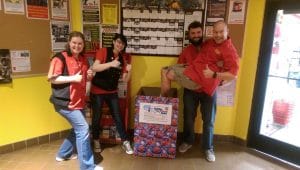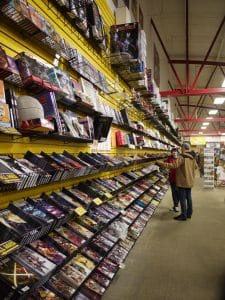Lisa Olsen is a hero. Lisa is with Source Comics and Games in the Twin Cities, so you might be thinking, “Chill, man. Heroes aren’t FLGS employees. A real hero does something brazen and life-saving. Like, maybe he or she gives some random dude on the street an emergency appendectomy or something.”
And that’s where you’re wrong. Lisa is a hero. Because bringing in new fans to board gaming or comics is absolutely heroic as far as I’m concerned, because the world needs more young readers and sharp thinkers.
So I asked Lisa a few questions to see if we could glean some advice on how to raise up the next generation of gamers and comic book fans.
Clave: Lisa, what does Source do to cater to young, new fans?
Lisa: First of all, seeing how happy comic books and games make people is a huge part of what makes this industry worth all the hard work. And no one is as exuberant in their joy as kids. Games and comics can be such massively formative and instructive things in life that any shop not recognizing that power and joy is just neglecting a whole vital arm of what we do.
Seeing how happy comic books and games make people is a huge part of what makes this industry worth all the hard work.
Our store is overwhelming because of our size, and comics and games are overwhelming in terms of the sheer number of them coupled with the ofttimes incomprehensible nature of their history to outsiders. We try to mitigate some of that off-putting stuff by having a kids section right around the corner from the front door, with as many face outs as possible and more clever signage to help people know what they’re looking at.
We also just rearranged a bunch of our shelves and took the opportunity to move the kids’ trades closer to the front of the store and expanded it. It helps us to have those books closer to the registers to make it easier to talk to people who are there.
We also make a point to talk to the kids directly as much as possible. Kids are so much smarter and more savvy than they get credit for. Sure, the guardian has the wallet, but it’s the kids’ experience just as much as theirs. And it’s the kids’ relationship with comics and games that really matters in the long run. There’s more than enough gatekeeping in the world of comics and games – the best thing you can do, as someone who works in one of these stores, is to just help anyone who walks in find whatever it is they connect with.

Sure, I’m here to make money, but it truly winds up being a function of the relationships you create in a store. Amazon is there to facilitate the hard exchange of goods for money. I’m responsible for everything else. And new fans and young fans are the most important part of that “everything else” because it dies without new people coming to this stuff.
Clave: What do you do personally to connect with new, young fans?
Lisa: I make a serious effort all the time to assure people that when I walked into the Source for the first time that I didn’t know anything about anything. Everyone starts from zero and just because you don’t know what’s going on doesn’t mean you’re not welcome.
When I talk to kids I try to talk to them, not to their parents. I ask them what they like, what they see that they think is neat, and I frequently try to crouch or sit on the floor with them so I’m not towering over them.
I also encourage them to tell me what they don’t like. So much of all of our lives is about trying to meet expectations, and I feel like when kids are learning to socialize with people they don’t know they’re encouraged to be nothing but polite and agreeable. That’s totally correct on one hand, but I want them to feel empowered by all of the fun stuff here. They get to have their own opinions. If a kid is so-so on a book I’ve handed them, I tell them that if they don’t like it they can come say “I told you so” and we can find something else. There’s so much of learning about yourself involved in games and comics that I want every kid who comes in here to know they can try things with the possibility that they may not work, and know that they can just pick up the next thing and see how that goes.

There are so many comic book characters that appeal to the ideas of hope and optimism in the world. It’s a nice, warm, fuzzy message, but I think that idea has persisted across the genre because it’s also about giving yourself opportunities to try things and be different things. I want all of my interactions with kids here to reflect that excitement about possibilities and opportunities. Because every book and every game box in this building represents those overwhelming multitude of opportunities and possibilities, and instead of seeing it as work, or another transaction between adults in their lives, I want kids to see it as their playground too.
Clave: First of all, thank you so much for your kindness toward my daughter. What do you personally see happening among young female fans?”
Lisa: There are so many more women in creative positions in comic and game companies, so many more female characters that aren’t just a girl version of another boy character, and so many non-superhero characters now in comic and games for kids it’s just wild. I would have lost my little kid mind over the stuff that’s around now. Multiple girl Jedi in the new Star Wars properties? Come on.
The new WizKids Wardlings line of minis is a great example of this in the gaming world, too – they’re prepainted, kid-ish figures with cute familiars allowing all kids to see themselves in gaming spaces like they haven’t before. And those female figures stand alone just as much as the male ones do. Representation is everything, and the more representation across the board, the better. It’s always going to mean more people being included, more stories, more options.
When I was little, I was relegated to playing with the boys if I wanted to know anything about Captain America or Pocket Monsters or whatever. The biggest difference now are things like DC Superhero Girls, where girls get their whole own group of heroes. [Note: My daughter reviewed this line last year.] But also things like Gravity Falls, where it’s a boy and a girl and everyone gets to have fun with that stuff together. There’s less stigma, less negative connotations around nerd stuff in general, and less of that about girls being interested in it too, which allows all kids to see nerd stuff as something fun that’s open to them.
At first women had to put more effort into staking out a place in a man’s world. We still had to come to this space that was really defined by men, and full of men, and you had to be more motivated to push yourself into that space. Now, as more and more women are more visible in the nerd world, there’s more entry points, and less resistance, so there are more and more female fans all the time coming in and asking about this comic or that comic they’re interested in. It’s still a changing world – obviously things like GamerGate still happen and there are lots of places that women do not feel welcome. But the more that women see each other in these spaces, just enjoying the things they enjoy, the more comfortable new fans get.
Clave: Lisa, I can’t thank you enough, both for the help you’ve shown my daughter when she was in the store, as well as all the work you’ve done to invest in young fans.

